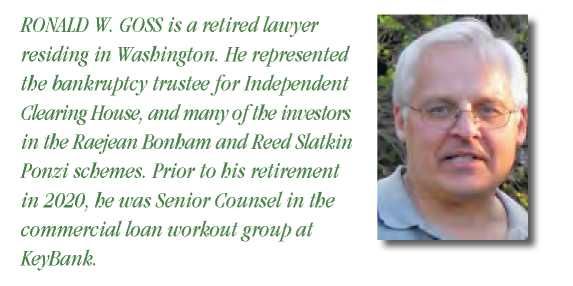Article
| Publication year | 2023 |
| Pages | 18 |
May, 2023
Milestones in the Judicial Evolution of Ponzi Clawbacks
by Ronald W. Goss
Ponzi clawbacks are suits by bankruptcy trustees and equity receivers to recover payments to investors and others made in furtherance of a Ponzi scheme. Next year will mark the one-hundredth anniversary of Cunningham v. Brown, the first Ponzi clawback case. 265 U.S. 1 (1924). Since that landmark decision, through statutes, amendments to statutes, and a large body of case law, Ponzi clawbacks have become a distinct subset of fraudulent transfer and preference law. The statutes were not designed to unwind Ponzi schemes or reallocate losses from large-scale fraud, but they have given federal courts the tools to craft a body of law that enhances the recoveries of the most unfortunate victims and fairly approximates justice. This article will examine the judicial milestones in the evolution of Ponzi clawbacks and explore how courts have crafted various remedies to make the square peg facts of Ponzi schemes fit into the round holes of the avoiding powers.
From Independent Clearing House to Rust Rare Coin, Utah has spawned numerous Ponzi schemes. For lawyers who may not be versed in this species of fraud, a brief introduction to the language and concepts of Ponzi clawbacks may aid in understanding the cases discussed herein.
The Language of Ponzi Clawbacks
A Ponzi scheme is an investment fraud in which returns are paid from principal collected from other investors rather than profits or earnings of a legitimate business. See SEC v. Mgmt. Sols., Inc., No. 2:11-CV-1165-BSJ, 2013 WL 4501088, *7-19 (D. Utah Aug. 22, 2013) (collecting definitions). Ponzi schemes can work for a while, but they inevitably collapse when the pool of new investors dries up or enough earlier investors ask for their money back. Since all Ponzi schemes depend upon infusions of new investor funds, positive returns whether labeled "interest," "profits," or "earnings" are commonly referred to as "fictitious profits."
Generally, all Ponzi scheme investors are both innocent victims and unwitting accomplices of the fraud. When the scheme collapses, a few will be "net winners" who managed to withdraw more money than they invested, but most are "net losers" who received only a portion of their investment (or nothing at all). A Ponzi scheme's assets are never sufficient to make the victims whole, but using fraudulent transfer and preference statutes, trustees and receivers are able to recapture certain transfers and equalize investor losses to some extent.
The Federal Bankruptcy Code contains a fraudulent transfer provision, 11 U.S.C. § 548(a), as well as a "borrowing" or "derivative standing" provision, 11 U.S.C. § 544(b), which allows a trustee to step into the shoes of a "triggering creditor" who could have avoided the transfer under state law. There are no fraudulent transfer statutes specifically designed for equity receivers, so they employ state statutes, typically the Uniform Voidable Transactions Act, Utah Code Ann. § 25-6-101 et seq, or its predecessor, the Uniform Fraudulent Transfer Act, Utah Code Ann. § 25-6-1 (repealed).
There are two types of fraudulent transfers, commonly known as "actual" and "constructive" transfers. Transfers made with subjective intent to "hinder, delay or defraud" creditors are "actual fraudulent transfers." 11 U.S.C. § 548(a)(1)(A); Utah Code Ann. § 25-6-202(1)(a). The focus is on the debtor's state of mind, not the adequacy or equivalence of the consideration provided for the transfer. Except where the debtor admits fraudulent intent in a plea agreement, intent is almost always established by circumstantial evidence. Proof that the debtor operated a Ponzi scheme triggers the widely recognized "Ponzi

scheme presumption" that all investor payments were made with intent to hinder, delay, or defraud creditors. See, e.g., Donell v. Kowell, 533 F.3d 762, 770 (9th Cir.), cert. denied, 555 U.S. 1047 (2008).
The "good faith defense" allows a Ponzi investor to retain payments up to the amount of his original investment by establishing that the payments were taken in good faith. 11 U.S.C. § 548(c); Utah Code Ann. § 25-6-304(1). If the investor fails to prove good faith he must disgorge the entire transfer, including amounts that could be considered return of principal. Jobin v. McKay (In re M&L Bus. Mach. Co.), 84 F.3d 1330, 1338-39 (10th Cir.), cert. denied, 519 U.S. 1040 (1996).
Transfers by an insolvent debtor in which the debtor receives less than "reasonably equivalent value" in exchange are "constructive fraudulent transfers." 11 U.S.C. § 548(a)(1)(B); Utah Code Ann. § 25-6-202(1)(b). Since Ponzi schemes use investor money, not profits, to pay returns, they are inherently insolvent at all times; hence proof that the debtor operated a Ponzi scheme establishes its insolvency. See, e.g., Hafen v. Taylor, No. 2:19-CV-00896-TC-JCB, 2022 WL 3452819, *2-3 (D. Utah Aug. 17, 2022). "Fictitious profits" received from a Ponzi investment are considered a windfall, and nearly all courts have adopted the "principal only" rule that an investor gives "value" to a Ponzi operator in the amount of his principal investment, but not as to any profits, interest, earnings, or other positive return. See, e.g., Donell, 533 F.3d at 771-72.
The "reachback period" for fraudulent transfers under the Bankruptcy Code is two years. 11 U.S.C. § 548(a)(1). A trustee exercising derivative standing under 11 U.S.C. § 544(b) can reach back as far as state law would allow the triggering creditor. The Uniform Voidable Transactions Act, like its predecessor, the Uniform Fraudulent Transfer Act, has a four-year statute of limitations and a one-year discovery rule for transfers made with actual intent to defraud. Utah Code Ann. § 25-6-305. If the IRS is the triggering creditor, the ten-year collection period under IRC § 6502(a) preempts state statutes of limitation. Gordon v. Webster (In re Webster), 629 B.R. 654, 674-75 & n.18 (Bankr. N.D. Ga. 2021) (collecting cases).

Preferences are transfers by an insolvent debtor to a creditor made within ninety days of bankruptcy (or one year if the creditor is an insider) that enable the preferred creditor to receive a greater percentage of his claim than he would receive in a bankruptcy distribution. 11 U.S.C. § 547(b). From the very first Ponzi clawback case, payments received by investors within the statutory reachback period have been held to be preferences. Cunningham, 265 U.S. at 10-11. A statutory safe harbor, known as the "ordinary course of business defense," shields certain transfers from preference liability. 11 U.S.C. § 547(c)(2). In Ponzi cases, the great weight of authority holds that the ordinary course defense does not apply to investor payments. See, e.g., Sender v. Nancy Elizabeth R. Heggland Family Trust (In re Hedged-Invs. Assocs., Inc.), 48 F.3d 470, 476 (10th Cir. 1995).
The Evolution of Ponzi Clawbacks in the Courts
Cunningham v. Brown, 265 U.S. 1 (1924)
The law of Ponzi clawbacks began, fittingly, with its namesake, Charles Ponzi. Ponzi borrowed money on notes payable in ninety days at 50% interest...
To continue reading
Request your trial
